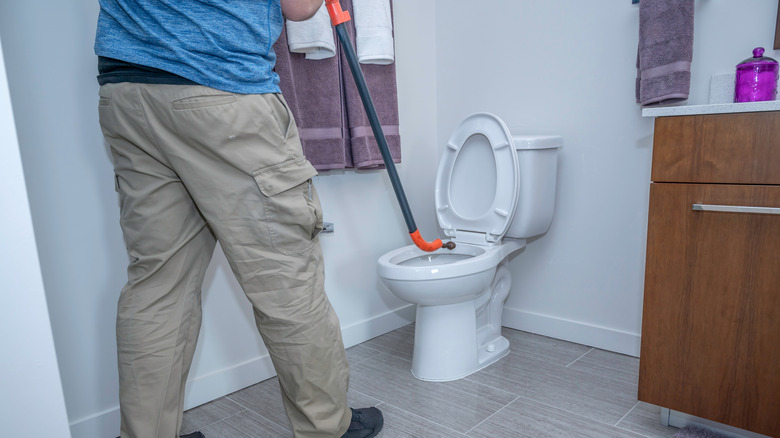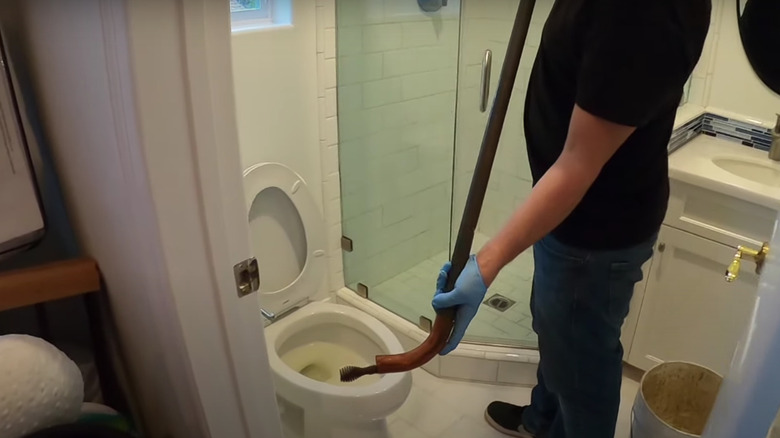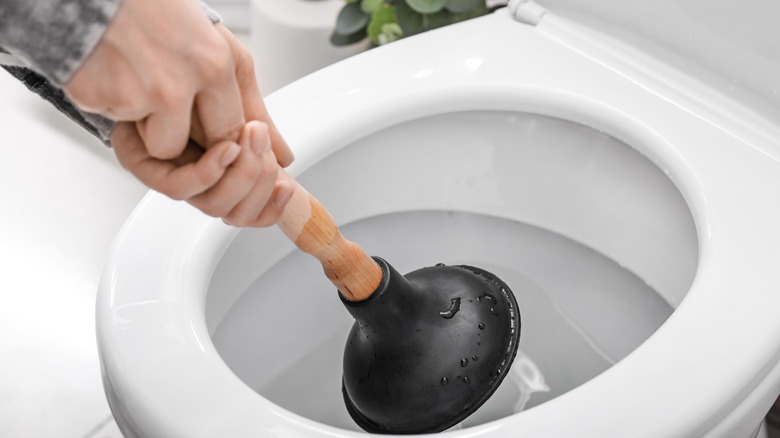What Is A Toilet Auger And How Is It Different From A Plunger
Let's face it, clogs happen, and when it happens to your toilet, you want to make sure you have the right tool handy to take care of the job. When it comes time to fix an annoying clog, most folks would probably reach for their handy plunger. These commonplace bathroom tools create an airtight seal over the toilet's drain, allowing you to create a blast of pressure by pressing down rapidly. Hopefully, the pressure changes can dislodge the blockage, but if it's located a little farther down the pipe than you might think, the sucking pressure created when using a plunger may not be enough.
Dealing with a severe clog may require using a specialty tool fit to handle more significant problems. When applying pressure with a plunger won't do, try using a toilet auger. A toilet auger — also known as a closet auger — is a tool that consists of a long metal cable with a pointed tip at one end and a cranking mechanism at the other. It works by traveling down your pipes and breaking through the blockage, making it possible to easily flush the debris through.
The difference between a toilet auger and a drain snake
If you've seen a toilet auger before, you may have mistakenly called it a drain snake, as the two look pretty similar. Although the differences may be subtle, they are meant for alternative areas. A toilet auger is typically longer than a drain snake and is best suited for toilet pipes with a width of 1½ to 3 inches. When feeding the auger down the pipe on the way to the clog, you should turn the crank handle slowly in a clockwise motion so that it can smoothly make its way through. Once you feel like you can't turn it anymore, you have likely reached the problem and can push the auger until it makes its way through the blockage. Finally, retract the tool and try flushing to see if the clog has been eliminated.
A drain snake is smaller than an auger and should only be used on sinks or toilets that have pipes under 2 inches wide. At the end of the cable of a drain snake, there is a small hook-like attachment. Instead of pushing through the blockage, a snake can be turned at the clog so the hook grabs hold of the problem and pulls it away. Snakes are more appropriate for shallow toilet clogs or deeper blockages in your sink.
When to use a plunger, toilet auger, or other alternatives to fix a clogged toilet
Many situations can cause a clog in your toilet, such as a large amount of waste, using too much toilet paper, or attempting to flush items down the toilet which aren't meant to be flushed. This causes a block in the S-shaped pipe in your toilet called a toilet trap. The pipe helps to prevent tough clogs from making their way further down your pipes which would lead to more significant issues. To remove this problem, use a toilet plunger and try to create enough suction to loosen the issue. If that is unsuccessful, that is when you can use a toilet auger to work its way through the clog.
If you don't have a plunger to unclog your toilet or an auger to help yourself out of a messy situation, there are other alternatives you can try. For example, try adding boiling water to your toilet bowl after removing still water. This may help to break up the blockage. Or, if you have an old soda bottle lying around, you can use it to pump air through the pipe in the bottom of your toilet bowl. This rush of air can act in the same way as a plunger and help to push the debris through. Also, store-bought toilet cleaners or a mixture of baking soda and vinegar can aid in breaking up a clog.


